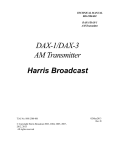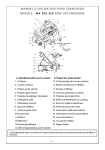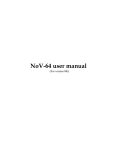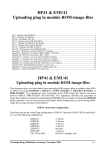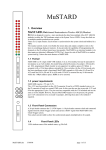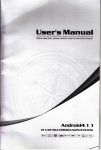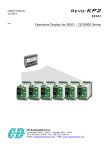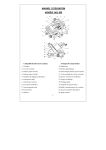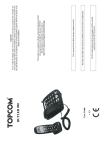Download Clonix & NoV`s module family comparative chart.
Transcript
Clonix & NoV's module family comparative chart. Module > v Features ROM size Clonix-41 Clonix-D NoVRAM 24Kwords 48Kwords 24Kwords 12 6 NoV-32 NoV-64 Notes Details 24Kwords 48Kwords 1 Page 3 6 12 ROM pgs. 6 ROM organization One block RAM Size 512 words N/A 16Kwords 32Kwords RAM pgs. (1/8)* N/A 4 4 pgs HEPAX Two blocks 4 pgs HEPAX 4 pgs HEPAX 4 + 4 user avl. 6 pags each + 2 user avl. + 2 user avl. sw. selectable Page 3 2 Page 3 64Kwords 3 Page 4 8 16 4* Page 4 Two blocks pgs #8 - #B sw. selectable Four blocks pgs #8 - #F 16K & 32K sw. selectable RAM organization Page #F N/A One block pgs #8 - #B Page Shadowing Yes Yes Yes Yes Yes 5 Page 4 HEPAX ROM** No Yes Yes Yes 6** Page 5 HEPAX Relocation No N/A Yes Yes Yes 7 Page 5 HEPAX RAM protec. N/A N/A Yes Yes Yes 7 Page 5 2x 41's Yes No No No No 8 Page 5 41CL compatible Yes Yes Yes Yes Yes 8 Bank Switching Yes Yes Yes Yes Yes 9 Special modules and devices emulation. - Diagnosis modules - Diagnosis modules - Diagnosis modules - Diagnosis modules - Diagnosis modules - Advantage - Advantage - Advantage *** - Forth-41 (11) - Advantage *** - Advantage - Double -Dbl. HEPAX Diag. Mods. RAM -Dbl. HEPAX RAM -Dbl. HEPAX RAM - Forth-41 (11) - Forth-41 (11) - Double X-MEM 10*** - Double X-MEM RAM-box NoVRAM-M RAM-box NoV-32-M Page 6 Page 6 11 - HP41CY (12) Third party Apps. See NoV's manuals. 12 13 Brief notes: 1. Size is referred to total ROM available to hold HP-41 pages. Internal program is also contained into ROM. All modules are built using Flash ROM microcontrollers which can be reconfigured using the USB programmer and its corresponding adapter for the module's edge connector. 2. Since the ROM addressable space in the HP-41 is limited, mapping of “on-line” pages is required. Clonix-D switches its ROM blocks by changing the port it is plugged into. Even ports enable block 1, while odd ports enable block 2. 3. RAM memory used in all NoV's modules is non-volatile, therefore it will retain its contents even if the module is disconnected. No battery back-up or other means are required to hold the data, therefore it can be considered like “writeable ROM”. 4. The 512words available in the Clonix6P configuration are “volatile” and its contents will be lost as soon as the module is unplugged. It is placed in the lower address range of page #F (h'F000 – h'F1FF). This is intended for the user to experiment with some basic M-code. 5. When a physical module is plugged into a port which addresses are occupied by ROM or RAM pages in a Clonix or NoV module; the page in the Clonix or NoV will set itself in “shadow mode” allowing the user plugged in module to operate without conflict. 6. An only-ROM HEPAX version for Clonix-41 user to test its features is available at www.clonix41.org, under the Clonix-41 project page. 7. NoV's modules are the only devices that currently implement full HEPAX functionality including relocation (instruction h'030) and RAM page write protection (instruction h'1F0). 8. So called “2x speed-up” 41's which usually run at 1.7x (about 620KHz) are supported only by the Clonix-41 module when configured using the Clonix6P version. It has been tested up to 617KHz. This has nothing to do with 41CL “Turbo” mode which affects only to the internal 41CL operation speed while keeping module access at standard clock rate and fully compatible with all Clonix & NoV's module families. 9. All modules are Bank Switching capable and can decode all four ENBANK instructions. 10. Advantage needs 12K to be loaded. Since NoVRAM and NoV-32 only have 2 extra ROM pages a workaround is required. Details of the procedure and the relevant files are available at www.clonix41.org under NoVRAM project page. This is fully compatible with NoV-32. 11. Forth-41 makes use of page #4 and is not compatible with NoV-32 and NoV-64. Originally Forth-41 also made use of page #5 which renders it unusable on CX's. A modified version is available in the ClonixConfig utility to overcome this CX limitation. 12. HP-41CY unique bankswiching escheme and RAM shadowing (see note 5) are fully emulated using NoV-64. The CY turbo (2x) mode is not available though. 13. Recently, there has been some applications intended to allow different configurations for the NoVRAM and NoV-32 modules. Visit www.hp41.org to find details of these options from Christophe Gottheimer. ROM details: All modules occupy one single physical port, however, they can be configured with up to 12 pages, therefore, a means to properly maps these pages into available space is needed. The ROM area in the HP-41 calculators is composed by 64Kword, divided into 16 pages of 4Kwords each. Note that the word length is 10bits so 5Kbytes are required to hold a ROM image. ROM Pac modules can be 1, 2 or 3 pages (4K, 8K or 12K). It is important that the user gets acquainted of the different type of modules end their size in order to obtain the most out of the Clonix or NoV's modules. As a starting guide, here are a description of the ROM distribution of the Clonix/NoV family: Clonix-41 holds up to 6 pages which can be mapped at the time of configuration, into any of the available area from page #6 to #F Clonix-D can be programmed with up to 12 pages, however, at any given moment the user will see a block of up to 6 pages (just like a Clonix-41). Clonix-D will switch from one block to another by swapping it from an even port to an odd one and vice-versa. Quite like having two separate Clonix41 in the same device. The address range for Clonix-D is also pages #6 to #F. NoVRAM and NoV-32 uses four of their six ROM pages to hold the HEPAX images. Thus two extra pages are available for the user to include his/her favourite ROM images. Since HEPAX RAM fulfils pages #8 to #B, recommended area to include the extra ROM pages is pages #C to #F. NoV-64 also includes HEPAX emulation and uses four pages to hold the required HEPAX ROM images. Another two blocks of 4 pages each are still available for the user. The number of possible configuration options exceeds the focus of this simple document; please refer to the NoV-64 user manual, for further details on the many configuration possibilities of this module. RAM details: All NoV modules use RAM to hold the HEPAX File System or ROM images transferred for the user either from a mass storage media or from physical ROM's. The HEPAX File System (FS) allows the user, among other things, to convert FOCAL programs to ROM-like images that can be executed as if they were part a on external module, freeing the “user RAM” for other uses. HEPAX FS is organized into registers but they have nothing to do with registers in the “user RAM” of the HP-41. FS registers are built using 6 bytes instead of 7. It can also hold Key assignments, ASCII files, etc. For a detailed description of the HEPAX File System functions and features please consult the HEPAX manual volumes 1 & 2, available at www.hp41.org. Note: A reprinted and searchable version of the HEPAX manual vol. 2 is also available at www.clonix41.org and included in the .zip updated archive along with the rest of documents and software required for the Clonix & NoV's modules. NoVRAM is built with 16Kword (4 pages) of non-volatile RAM. Initially this RAM will be configured as a single chain HEPAX FS with 2,610 registers. Any single page in the HEPAX RAM can be removed from the FS chain and dedicated to hold any info, from ROM images copied from mass storage to M-code projects of the user. NoV-32 allows two different blocks of RAM (4 pages each) to be selected by user simply entering an odd or even value into control word at address h'4100. Third party software allows 32K RAM in NoV-32 to be used as a single FS chain from page #8 to page #F. NoV-64 contains 4 blocks of non-volatile RAM (4 pages each) and it can be configured both in 16K and in 32K modes by software using the control word also located at address h'4100. Again, NoV-64 user manual reading is advised in order to get full understanding of the RAM configuration possibilities of this versatile module. Page shadowing: Due to the limited addressable space in the HP-41 systems, and the many ROM images that can be contained by either RAM or ROM in the Clonix & NoV modules; chances are that most every page will be occupied by an image loaded into them. In this scenario, if the user wants to plug a different ROM an address conflict will arise. To avoid this situation, Clonix and NoV modules hide their own pages in the “shadow” while any physical ROM module is plugged and using an address range on their space. The images in the Clonix or NoV will be available again as soon as the physical module gets removed. Please note that the FS may be altered by this procedure, see HEPAX manual for considerations on how to preserve FS chain integrity. HEPAX emulation: Main target of the NoV's modules development was aimed to offer a full functional replica of the extremely difficult to find HEPAX module. This module offers the user a unique range of tools, commands and functions that covers most every single instance of the usage of HP-41 systems, from simple user code (FOCAL) programs, to data and file handling and transfers to and from HP-IL mass storage media, and even M-code user developed programs and ROM images. Some of the features of this module require a small amount of imbedded “intelligence” to decode a few instructions dedicated to handle special funcions in the HEPAX hardware. One of the most celebrated abilities of the HEPAX module is its capacity to allocate itself into the lowest address available page. To achieve this HEPAX (and NoV's) uses pseudo-instruction h'030 which is a simple NOP for the NUT processor but causes HEPAX code to reallocate. Another useful tool of the HEPAX module is the software controlled RAM write protection. Former RAM boxes use a DIP switch in order to prevent RAM contents to be accidentally erased or modified. HEPAX (and NoV's) make use of yet another pseudo-instruction, namely h'1F0 to set or clear a register flag which enables or disables the possibility of writing in a given RAM page. Please see NoV-64 manual for details on the extended RAM protection feature implemented to handle the many RAM configurations available for this module. HEPAX not only offers a great amount of functional power to the user but also keeps an extremely small memory footprint, installing its 16K into a single page by using of a four bankswiching scheme. The four intructions required for this task are called ENBANK 1 to 4 and are also part of the NoV's A dedicated and modified version of the Clonix-41 software intended to allow the users to familiarize with the HEPAX command was developed and is available for download. It has no RAM and therefore no File System, but still have many useful features. See note 6. Turbo (speed-up) HP-41's: Back in the early eighties, some users found their HP-41's were able to run at a higer rate than the standard 360KHz. Some sort of “overclocking” was designed and implemented allowing speed to run up to twice (2x) the original clock frquency. Most of these mods just allow about 1.7x, Currently it doesn't seem that this trend is still active, even less after the new HP-41CL allow internall clock speed up to 50x while keeping full I/O compatibility at 1x. Nonetheless, Clonix-41 allows the user to run any ROM pac on 1.7x speed-up 41's by use of the Clonix6P software code. This is available as an option in the ClonixConfig utility interface. Bank Switching: All of the Clonix and NoV's modules support Bankswitched ROM's, and decode the four standard ENBANK intructions. Only three modules are known to make use of this technique though: -Advantage Pac which uses only banks 1 & 2 in its upper page, with a total of 3 pages. -Infrared Printer which also uses banks 1&2 in page 6 (note that this is a peripheral not a ROM Pac) -HEPAX which uses all four banks and allocates itself in the lowest available page. Also, W&W 64 RAM Box and its HP-41CY implementation uses a modified Bankswiching scheme which is also supported by NoV-64 in its amulation of the CY device. Special Applications: Some of the modules and devices developed along the HP-41 lifespan, required of a special configuration or take advantage of some charasteristic that makes them different from the rest of the Application ROM modules. – Diagnostic modules, also known as Service Modules make use of the take over feature in the page #4 of the HP-41. They can be configured in any Clonix or NoV module for the user to perform the available tests. See the HP-41 service manual for a detailled description of the testing procedure. In a Clonix-D, the user can even load both Service modules, and swap between them by changing the port. – Forth-41 also makes use of page #4, so it also requires of a special dedicated code to be used in the Clonix and NoV's. For this reason, and since H'4100 contains configuration word in NoV-32 and NoV-64, this ROM is not compatible with these modules standard configuration. It is nonetheless backwards compatible and can be configured in a NoV-64 by selecting Clonix-D mode, or in a NoV-32 by selecting ClonixLP/6P or NoVRAM. – HEPAX modules also allows the user to add more RAM memory to its system with HEPAX RAM modules. To replycate this special module NoV's can be configures to behave like the Double HEPAX RAM memory module. – NoV-64 and Clonix-D can be configured to add a Double Extended Memory to your CX (or C/CV with X-FUM MEM module) for a total 600 registers. – The HP-41CY includes a W&W 64K Ram-Box into a standard HP-41CX halfnut. NoV-64 can replicate the functionality of the 41CY implementation. The turbo 2x operation mode is not available though. Diego Díaz. [email protected] Feb. 2012






